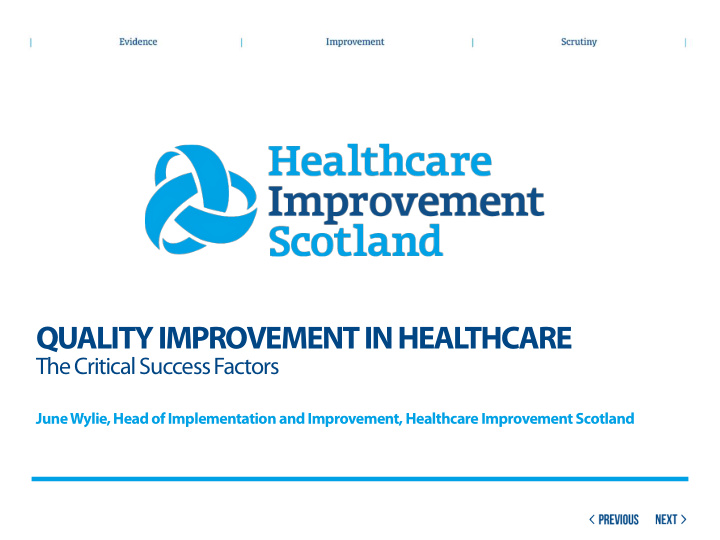



QUALITY IMPROVEMENT IN HEAL THCARE The Critical Success Factors June Wylie, Head of Implementation and Improvement, Healthcare Improvement Scotland
INTEGRATION AGENDA NOT NEW ! Key policy objective since 1970 • Joint working • Partnership working • Joint Improvement Fund • Single shared assessment • LHCC • Managed Clinical Networks and, and, and
KEY FACTORS INFLUENCING INTEGRATED WORKING Policy frameworks • Joined up Realistic Local planning context • Joint acceptance of unmet need Vision owned at all levels Operational factors • Relationships Cultures Behaviours
QUALITY IMPROVEMENT IN HEALTH • Audit • Clinical Governance • Business Process Redesign • Total Quality Management • Clinical Effectiveness • Quality Assurance • HEAT Targets • Research
DEFINING QUALITY IN HEALTHCARE To Err is Human-2000 Crossing the Quality Chasm-2001
HEALTHCARE QUALITY STRATEGY Safe Effective Person Centred Efficient Timely Equitable
CRITICAL SUCCESS FACTORS IN QUALITY IMPROVEMENT What the literature says • Need to understand system • Value role of customer • Reduce variation • Leadership at every level • Data and measurement • Resources to support implementation and staff development
LARGE SCALE IMPROVEMENT • Culture • Context • Leadership
CULTURE • Increasing recognition that culture of hospital or healthcare system has a significant impact on its ability to achieve improvement • High profile failures have demonstrated that informal psychological and social aspects of an organisation play a significant role in performance • Few hospitals taking steps to assess or understand their culture • Organisations which focus on teams and supportive infrastructures to support innovation and staff development perform better
CONTEXT • Size • Teaching status • Leadership • Competition • Culture • Years involved in quality improvement activities
LEADERSHIP • Identified in almost all literature as critical. • Leadership at every level (wicked problems cannot be solved by one person alone) • Key leadership behaviours and skills Engagement and relationship skills Enabling and facilitating others • Clinical leadership essential- particularly medical staff
NATIONAL IMPROVEMENT PROGRAMME • What factors are influencing the implementation of neurology standards? • To what extent is the implementation and improvement support programme provided by HIS been successful in supporting NHS boards to implement standards?
IMPLEMENTATION SUPPORT Helpful Challenges • Identifications of an • Two year programme too improvement lead in every short board • Time limited funding • Improvement leads • Integration challenging network • Data on patient outcomes • Focused implementation • Leadership and support from HIS engagement at local level • Funding support
PRACTICAL APPLICATION • Clear clinical engagement/ leadership engagement strategy at start of any project • Culture/Language is important. Need to understand difference and similarities • Measurement for improvement • Consider my own leadership style • Spend more time engaging with staff and stakeholders
REFERENCES Bate, P. Mendel, P. & Robert, G., 2008. Organizing for Quality: the improvement journeys of leading hospitals in • Europe and the United States. Oxford: Radcliffe Publishing. Davies, HTO, Nutley,S. & Mannion,R., 2000. Organisational culture and quality of health care. Quality in Health • Care, 9, pp.111-119. Davies, H. Powell, A. & Rushmer, R., 2007. Healthcare professionals views on clinical engagement and quality • improvement . ISBN 0-9548968-6-6. London, The Health Foundation. Institute of Medicine, 2008. To Err is Human. Building a Safer Health System. 7 th ed.USA: National Academy Press. • Institute of Medicine, 2009. Crossing the Quality Chasm: A New health System for the 21 st Century. 9 th ed. USA: • National Academy Press. Mannion, R, Konteh, FH,& Davies HTO,.2009 . Assessing organisational culture for quality and safety • improvement: a national survey of tools and tool use. Quality and Safety in Health Care, 18, pp. 153-156. Mannion R,. et al 2010 Changing management Cultures and organisational Performance in the NHS (OC2).National • Institute for health research Parker, V. A et al 1999. Implementing Quality Improvement in Hospitals: The Role of Leadership and Culture. • American Journal of Medical Quality, 14 (1), pp.64-69. Stewart, A., Petch,A., Curtice, L., 2003 . Moving towards integrated working in health and social care in Scotland; form • maze to matrix. Journal of Interprofessional Care, 17, 4, pp.335-350 Ovretveit, J.,1997. A comparisons of hospital quality programmes: lessons for other services. International Journal • of Service Industry Management , 8 (3), pp. 220-235. Ovretveit, J.& Gustafson. D.,2002. Evaluation of quality improvement programmes. Quality and Safety in Health • Care ,11, pp, 270-275. Ovretveit,J., et al, 2002. Quality Collaborative: lessons from research. Quality and Safety in Health Care , 11 pp. 345- • 351.
Recommend
More recommend